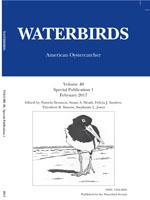American Oystercatchers (Haematopus palliatus) are present in North Carolina, USA, year-round. About 6–7% of the total Western Atlantic population winters in North Carolina. To estimate numbers of American Oystercatchers present during the non-breeding season, four major concentration areas were surveyed in North Carolina, each with multiple roost sites, from 2008–2013. Abundance of American Oystercatchers remained generally stable during the study period. The Lower Cape Fear River area had the greatest number of American Oystercatchers in all seasons. Mean peak abundance was greatest during winter at all concentration areas. Peak winter abundance was 158 at Ocracoke Inlet, 265 in Back Sound, 187 in Masonboro Sound, and 470 on the Lower Cape Fear River. Fall abundance was generally greater than spring abundance at all concentration areas except Masonboro Sound. Most banded individuals observed were marked in North Carolina as chicks or nesting adults, and they exhibited fidelity to concentration areas. About 15% of American Oystercatchers used wooden docks as roost sites; the rest used natural substrates and a man-made rock wall. At sites where roost habitat is a limiting factor, fabricated structures might be a useful substitute. Most roost sites receive no protection during the non-breeding season, and we observed sources of potential disturbance on 2.8–50.6% of surveys. Pedestrians and boats were the most common sources of potential disturbance.
How to translate text using browser tools
1 February 2017
Abundance, Distribution, and Geographic Origin of Non-breeding American Oystercatchers (Haematopus palliatus) in North Carolina, USA
Lindsay M. Addison,
Susan E. Cameron,
Angela M. Dwyer,
Walker Golder,
Sidney Maddock,
Sara H. Schweitzer
ACCESS THE FULL ARTICLE

Waterbirds
Vol. 40 • No. sp1
February 2017
Vol. 40 • No. sp1
February 2017
American Oystercatcher
distribution
disturbance
habitat selection
Haematopus palliatus
non-breeding
North Carolina




